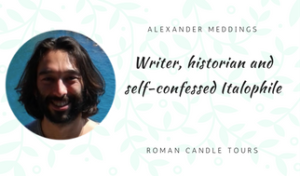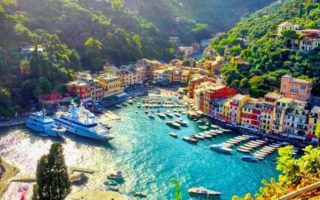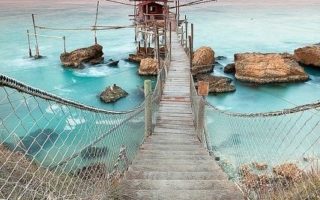What to Expect When Visiting Pompeii and Herculaneum
 |
| House of the Mosaic, Herculaneum. Pinterest |
It’s often said that with its abundant wealth of history Italy is like a window into the past. More than a window, I like to think of it as a glass-bottom boat: constantly moving, constantly changing, and, for those who want to dive off and explore for themselves, as interactive as it is immersive. But aside from the Eternal City, those wanting to transport themselves back to the world of Ancient Rome can do little better than the South of Italy.
First there’s Naples, the spirited monumental metropolis of the Mezzogiorno(a term for the Italian South). Its history stretches all the way back to the Stone Age, with the Greeks, Romans, Byzantines, Normans and Spanish—just to name a few—all leaving their marks on the city over successive centuries. Visit underground Naples on a tailored tourand you can discover this for yourself as you drill down through time to uncover each of its hidden layers.
Further south, just off the coast of Sorrento, is the Island of Capri and the palatial Villa of Jupiter, built by the Emperor Tiberius in the early first century AD. Ostensibly Tiberius ruled from this palace because he preferred the solitude of the island to the chaos of Rome. In reality, he moved there so he could let loose his perverted debaucheries and indulge his sadistic proclivities away from the prying eyes of the capital.
But for all the sites the South has to offer, none have permeated the world’s imagination quite like Pompeii. Emerging from the ashes that dramatically buried it for a millennia and a half around the year 79 AD, for centuries the site has been captivating its visitors as a city “frozen in time”.
Prior to its discovery we had just one surviving account of the volcanic eruption, a letter written by Pliny the Younger. Pliny described Vesuvius’s eruption in great detail: flames shooting out of Vesuvius’s crater, pumice raining down and pummeling everyone below, and the death of Pliny’s uncle, the encylopaedist Pliny the Elder, who fatally sailed across the bay to get a closer look.
 |
| Relief from the Lupanar (Brothel) at Pompeii. Metro |
By unearthing Pompeii’s buildings, not to mention the bodies of its people, we can bring Pliny’s account to life and reconstruct aspects of ancient daily life. This might involve one of the Roman elite luxuriating in one of Pompeii’s many villas, it might be one of Pompeii’s gladiators training in the city’s barracks, or it might be one of its prostitutes working away in the city’s brothel. Or, just maybe, it might be one of Pompeii’s thousands of “invisible” inhabitants: its slaves.
But when it comes to capturing the past, and journeying back in time to the day of the eruption and the weeks leading up to it, people often overlook Pompeii’s smaller, but much richer, sister city. Herculaneum.
Situated 10 miles north of Pompeii, Herculaneum was also completely buried by Vesuvius’s eruption. But rather than covered by four meters of ash like Pompeii, Herculaneum long lay under 20 meters of ash, mud, and other pyroclastic matter. This has resulted in a remarkably well-preserved site which offers arguably the world’s best window into the ancient past. Here at Roman Candle Tourswe’ll be looking at the history and legacy of both sites. And in doing so, we’ll try to answer an important question: what exactly can you expect to get from visiting each one?
Why visit Pompeii
People like to think of Pompeii as a city frozen in time. They see it as offering an invaluable snapshot of a cataclysmic moment; the freeze frame of a day in which—for reasons utterly inexplicable to the ancients—their world turned to fire and ash, and a blanket of darkness came down bringing the routines of their daily lives to a violent, unexpected end.
We’re told that echoes of this event still reverberate within the walls of Pompeii’s near-perfectly preserved buildings: its houses, brothels, amphitheatres and temples. More poignantly, we believe we can still hear these echoes from the city’s silent witnesses, its world-famous plaster cast population whose eternal death throes give us our most direct and personal conduit to the past.
But this isn’t the real Pompeii. The site might be a window of sorts to the ancient city of nearly 2,000 years ago. But it’s more accurate to think of Pompeii as a mirror that reflects what it wants its visitors to see and—by extension—what its visitors come expecting to see. This is because Pompeii isn’t static.
Despite what we’re told, Pompeii is a site in flux and—especially in these times of overcrowding and underfunding—adapting to survive. It’s not a time capsule from the ancient past. Or to put it another way, Pompeii is best understood when we see it as a highly sophisticated, cunningly deceptive, archaeological theme park.
 |
| European aristocrats “discover” one of Vesuvius’s victims. History Collection |
Pompeii has been tricking visitors since it was first officially discovered in the 18thcentury. European aristocrats, stopping off on one their grand tours, would be led into one of its many villae to be fortuitously greeted by the grisly remains of one of its ancient inhabitants who’d been placed there moments before. They may have believed they’d made a remarkable discovery; in reality they’d been treated to a piece of sublime stagecraft. But the magic had served its purpose: it kept them coming back for more.
Manmade, as well as natural, disasters have also played an important role in shaping the site we see today. Heavy bombing during the Allied campaigns of 1943 resulted in the destruction of vast swathes of the site, flattening Pompeii’s Amphitheatre and Large Forum and reducing much of the city’s rubble to well… even more rubble. It’s an inconvenient truth that a lot of today’s site has been reconstructed over the centuries, and that roads you walk on and buildings lining them, instead of 2,000 years old, may only be as young as 20.
 |
| American bombers flying over Vesuvius in 1944. Getty Images |
Even today Pompeii still tricks its visitors; it just does it more insidiously. It makes sense why. We like coherent narratives in history because we take comfort in certainty. And the story of Pompeii—its everyday life interrupted by unimaginable disaster, its poignant reminder of the transience of life, and its overwhelming sense of pathos—is effective enough as it is without being overcomplicated. But the risk with wandering around Pompeii on your own (and take this from someone who’s done it) is that you’re never quite sure what you’re looking at: not just whereit’s from, but also when.
The best way to avoid this uncertainty is by taking a Private Pompeii Tour. Especially in Pompeii, it really pays to have a guide who can bring the city to life. And this isn’t just because they can contextualise its architectural relics: the Temple of Apollo, the Temple of Jupiter, the House of the Faun and the Gladiator Barracks, to name a few. They can also bring to life the stories of those who lived, toiled, and died there; stories channeled through the Pompeii Bodiesthat have been (and continue to be) discovered there.
Despite being a trickster, Pompeii is still one of my favourite sites in Italy, if not in the world. But when it comes to transporting you back to a tangible past, Pompeii will always come runner-up to its lesser-known but better-preserved counterpart, Herculaneum.
Why visit Herculaneum
 |
| A grisly greeting: skeletons at Herculaneum’s boathouse |
At less than a third of Pompeii’s size Herculaneum is a lot smaller than its illustrious counterpart. This is partly down to the town’s function; a chic, sleepy seaside community (perhaps a little like Sorrento) in the shadow of Pompeii’s bustling metropolis (a little more like the historical centre of Naples). It’s also small, not least because a staggering 75 percent of the site is buried and is likely to remain so while the modern town of Ercolano still sits on top.
Where Herculaneum immediately differs from Pompeii is in its topography. Rather than seamlessly merging with today’s world, Herculaneum forcefully transports you back two thousand years by making you descend to the ancient level. The tunnel at the site’s modern entrance brings you right down to the ancient beachfront where you’re met with a particularly macabre sight. For sheltering in perpetuity within the vaults of the ancient boathouses are the skeletal remains of several dozen ancient inhabitants, grisly reminders of the desperation that gripped the town in its final hours.
 |
| Relief from the Collegium of the Augustales (college of the imperial cult) |
Penetrate deeper into Herculaneum and the narrative changes from human loss to material gain. There’s the House of the Wooden Screen, which, as its name might suggest, is home to the only surviving wooden screen from the ancient world. Also occasionally on display is a wooden cradle; a heart-rending object that begs a question of mortality which will never be answered.
One of Herculaneum’s most striking features is its resplendency of colour. Its frescoes, mosaics, columns and walls remind us that antiquity wasn’t black and white but was flushed with (often overly-garish) colour. Standing alone in an ancient painted room is indescribably transportive. And owing to the fact that fewer people know about Herculaneum, you’re much more likely to find this experience here than at its monolithic counterpart, Pompeii.
Another thing Herculaneum does more effectively than Pompeii is it gives you a sense of the ancient world from street level. You get this through some of the remarkable relics preserved in the eruption: including grain containers in a tavern and, in one of the town’s bakeries, an ancient oven (the charred bread it once contained has long since gone).
 |
| A perfectly preserved oven in Herculaneum’s bakery |
But the main way Herculaneum gives you a sense of walking down an ancient street is that it’s still lined by multi-story buildings, common designs in the Roman world despite being conspicuously absent from Pompeii. In fact if you want to get a real sense of what multi-story Pompeii might have been like, your best bet is to head down to the region’s capital Naples and wander around its historical centre.
Planning your visit to Pompeii and Herculaneum
There’s no point trying to pack two of Ancient Rome’s most immersive sites into a single day (believe me, I tried recently though thankfully it wasn’t my first time at either!). As a repeat visitor, I’d suggest a day for Pompeii and a morning for Herculaneum, after which, if you’re feeling energetic, you might want to try out the phenomenally intact villa nearby at Oplontis.
 |
| Wall relief from the Villa of Poppaea in Oplontis. S. Ranieri |
Entry to each site costs €11, with a series of concessions including for those aged between 18-25. If you’re planning on visiting three or more sites, museums, or galleries across the region during your vacation, it’s well worth picking up the Campania Artecard at one of the sites. You can choose between the three-day (€27) or seven-day card (€30): both give you free access to the first two sites and a 50 percent discount to any other thereafter. Be aware though that, for reasons unknown, free transport is only included on the three-day card.
How to get to Pompeii and Herculaneum
The most convenient way to get to Pompeii or Herculaneum from Naples, Sorrento, or anywhere else on the Amalfi Coast is by hiring a private driver. There is also the option of taking the train. Both sites are on the Circumvesuviana line connecting Naples and Sorrento, the journey from Sorrento taking 30 minutes to Pompeii and 45 to Herculaneum. Transport is free if you have the three-day Campania Card. If not, a single ticket to either site from Sorrento will set you back €2.10.
Where to stay near Pompeii and Herculaneum
If it’s a relaxing holiday you’re looking for, the coastal resort of Sorrento is your best bet. Ever popular with honeymooners and families, Sorrento is an ideal springboard for the area’s many attractions: besides Pompeii and Herculaneum, hop on a ferry or hydrofoil and you’ll be on the Island of Capri within 45 minutes. There is a wealth of options for accommodation, though if you’re looking for something central, luxurious, and relaxing, you can do little better than the four-star Grand Hotel Hermitage.
If on the other hand you’re looking to fill your days (and nights) with a more authentic taste of southern Italian culture, and you don’t mind a bit of chaos, confusion, and bad Italian driving, Naples is the place for you. Its public transport links mean its well connected to Pompeii and Herculaneum, and its historic centre is home to the magnificent National Archaeological Museum which not only contains an impressive array of original statues, mosaics, and everyday utensils taken from both sites (including cooking equipment and a gynecology toolkit), but also has a peculiar and not the least prudish room dedicated entirely to phalluses.
 |
| Artifacts from the “Secret Room” (room of phalluses) in Naples’s National Archaeological Museum |
On a material level, Pompeii and Herculaneum are unrivalled as immersive urban environments and treasure troves of historical trinkets. On a human level, both their stories offer poignant reminders of life’s unpredictability, given context by the sites’ buildings and given pathos by the skeletons or cast bodies of their ancient inhabitants.
Pompeii certainly deserves its A-list status, and should definitely be on your list of must-see places during your vacation. If you’re looking for a more intimate, quiet, and authentic conduit to antiquity, however, Herculaneum steals the show. But there’s only way you can make up your own mind: go and see both for yourself!


If you liked this article, read also “VISITING SORRENTO AND THE AMALFI COAST ON A BUDGET“



